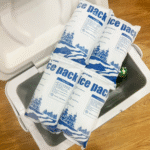Packs de glace en gel vs glace sèche: Quelle est la meilleure solution de chaîne du froid en 2025?
Dans le monde de la logistique de la chaîne du froid, the choice of cooling solution significantly impacts product integrity and shipping efficiency. Alors que nous entrons dans 2025, two of the most popular options for maintaining the right temperature during transit—gel ice packs and dry ice—continue to be widely used. This article will compare the pros, inconvénients, and applications of gel ice packs versus dry ice, helping you make an informed choice based on your specific needs.
-
The key differences between gel ice packs and dry ice
-
The advantages and disadvantages of each solution
-
How these cooling methods affect cold chain logistics
-
Quoi 2025 trends are emerging in the cold chain industry
What Are Gel Ice Packs and How Do They Work Compared to Dry Ice?
Packs de glace en gel are cooling agents filled with a gel-like substance that freezes at lower temperatures. They work by absorbing heat as they melt, maintaining a stable cooling temperature for longer durations. Gel packs are commonly used in food shipping, medical product transport, and other temperature-sensitive shipments.
Glace sèche, d'autre part, est le dioxyde de carbone solide (Co₂) that sublimes directly into gas at a temperature of -78.5°C. It provides ultra-low temperatures ideal for products that must remain frozen. Cependant, dry ice carries handling risks such as potential burns or frostbite and requires specialized storage and ventilation due to CO₂ gas release.
The main difference lies in the plage de température et sécurité des manipulations—gel ice packs maintain more moderate cooling, while dry ice delivers extreme cold but comes with additional risks.
Key Benefits of Gel Ice Packs vs Dry Ice
| Fonctionnalité | Packs de glace en gel | Glace sèche |
|---|---|---|
| Plage de température | -20° C à -30 ° C | -78.5°C |
| Sécurité de manipulation | Facile à manipuler, no special precautions required | Nécessite des gants, ventilation, and care to avoid frostbite |
| Impact environnemental | Biodegradable and recyclable | CO₂ EMISSIONS |
| Coût | Réutilisable, cost-effective long-term | Coût élevé, à usage unique |
Gel ice packs are safe and easy to handle, respectueux de l'environnement, and cost-efficient in the long run. En revanche, dry ice is ideal for extreme cold needs but requires careful handling and has a higher environmental impact.
How Does the Performance of Gel Ice Packs Compare to Dry Ice?
Gel ice packs are optimal for products requiring temperatures from 2°C to 8°C, comme les aliments frais, boissons, et produits pharmaceutiques. They provide a consistent cooling effect over extended periods (jusqu'à 48 heures), making them ideal for short to medium-duration shipments.
Glace sèche, cependant, is better suited for products that require ultra-low temperatures, such as biological materials, vaccins, or certain pharmaceutical products that must remain frozen. While dry ice lasts longer (jusqu'à 72 heures), its use requires proper ventilation and strict safety protocols to avoid CO₂ buildup.
Advantages and Disadvantages of Gel Ice Packs vs Dry Ice
Avantages des packs de glace en gel:
-
Manipulation plus sûre: Contrairement à la glace sèche, gel ice packs are non-toxic, do not pose frostbite risks, and can be handled without special equipment.
-
Écologique: Gel ice packs are typically reusable and made from biodegradable materials, Réduire un impact environnemental à long terme.
-
Rentable: Since gel ice packs can be reused, they provide a more economical solution over time, especially for recurring shipments.
-
Versatilité: They are suitable for a wide range of industries, y compris la nourriture, médicaments, et le commerce électronique, providing reliable cooling in many applications.
Inconvénients des packs de glace en gel:
-
Limited Temperature Range: Gel ice packs cannot achieve the extreme temperatures required for certain products, making them unsuitable for frozen goods.
-
Thawing Time: In hotter climates or extended transit, gel packs may require frequent replacement as they thaw faster than dry ice.
Avantages de la glace sèche:
-
Ultra-low Temperatures: Dry ice offers cooling temperatures far below freezing, ideal for materials requiring deep-freezing.
-
Longue durée: Dry ice can maintain a low temperature for extended periods, making it perfect for long-distance shipments or when freezing is essential.
Inconvénients de la glace carbonique:
-
Handling Risks: Dry ice can cause frostbite and requires ventilation due to the sublimation of CO₂ gas.
-
High Cost: Dry ice is often a one-time-use solution, which can be expensive for frequent shipments.
-
Environmental Concerns: The sublimation of dry ice releases CO₂, contributing to greenhouse gas emissions when not handled properly.
Choosing the Right Cold Chain Solution for Your Products
The decision between gel ice packs and dry ice largely depends on the Exigences de température, durée d'expédition, et sécurité des manipulations needed for your shipment.
For Gel Ice Packs:
Gel ice packs are ideal for goods that need to stay within a moderate temperature range (2–8 ° C), tel que:
-
Aliments frais (Par exemple, fruits, légumes, et produits laitiers)
-
Pharmaceuticals and vaccines
-
E-commerce shipments for groceries and meal kits
Use Cases: Gel ice packs are also suitable for industries looking for sustainable, low-cost, and safe shipping options. Par exemple, a grocery delivery service can benefit from gel packs to keep food fresh without risking the products freezing.
For Dry Ice:
Dry ice is essential when dealing with products that need freezing temperatures, tel que:
-
Frozen food and meats (Par exemple, glace, fruit de mer, et repas surgelés)
-
Biological samples and laboratory research materials
-
Medical supplies that need to remain deep-frozen
Use Cases: Dry ice is commonly used in the shipping of biological materials, laboratory equipment, and specialty products that cannot afford temperature variations or spoilage.
Trends and Innovations for Cold Chain Logistics in 2025
À mesure que nous approchons 2025, cold chain logistics is being shaped by advancements in technology, durabilité, and packaging materials. Packs de glace en gel are increasingly being developed with Matériaux à changement de phase (PCMS) to extend cooling durations, alors que glace carbonique alternatives focus on reducing carbon footprints. En plus, plus écologique gel ice packs and capteurs intelligents are being integrated into cold chain solutions to monitor temperatures in real time and reduce inefficiencies.
Market projections suggest that the marché de la logistique de la chaîne du froid is set to grow by 10% annually as sustainability becomes a larger focus for both businesses and consumers. Recyclable packaging for dry ice and hybrid cooling methods combining gel ice packs and dry ice are gaining traction.
Common Questions About Gel Ice Packs vs Dry Ice
Q1: Are gel ice packs safer to handle than dry ice?
Oui, gel ice packs are non-toxic and do not pose risks such as frostbite or asphyxiation. They are safe for consumer-facing deliveries and do not require specialized equipment.
Q2: How long do gel ice packs stay cold?
Gel ice packs typically maintain a 2–8°C temperature for up to 48 heures, depending on the insulation and pack size.
Q3: Can gel ice packs keep meat frozen?
Non, gel ice packs are not suitable for frozen items. For frozen meats or ice cream, dry ice is necessary to maintain sub-zero temperatures.
Q4: Are there regulations for shipping with dry ice?
Oui, dry ice is classified as a hazardous material and must be shipped according to specific regulations. Packs de glace en gel, d'autre part, have no special regulatory requirements.
Conclusion
Choisir entre packs de glace en gel et glace carbonique boils down to the nature of the product being shipped and the required temperature. For refrigeration needs, packs de glace en gel are a safer, plus durable, and cost-effective option, alors que glace carbonique is indispensable for ultra-low temperature requirements. By evaluating factors like plage de température, durée d'expédition, sécurité, et impact environnemental, you can select the best solution to ensure the safe and efficient transport of your goods.
Informations exploitables:
-
Évaluez les besoins en température de votre produit: Refrigeration requires gel ice packs, while freezing requires dry ice.
-
Combine solutions for hybrid shipping: Use both gel ice packs and dry ice for shipments requiring varying temperatures.
-
Restez à jour avec 2025 tendances: Invest in eco-friendly materials and smart monitoring tools to enhance your cold chain logistics strategy.
À propos du tempk
Tempk is a leader in cold chain packaging, proposant des produits innovants packs de glace en gel et Solutions de glace sèche to meet diverse logistics needs. Our products are designed to ensure safe and efficient shipping for temperature-sensitive goods, with a focus on sustainability and compliance. Contact us today to learn how our solutions can optimize your cold chain operations.























